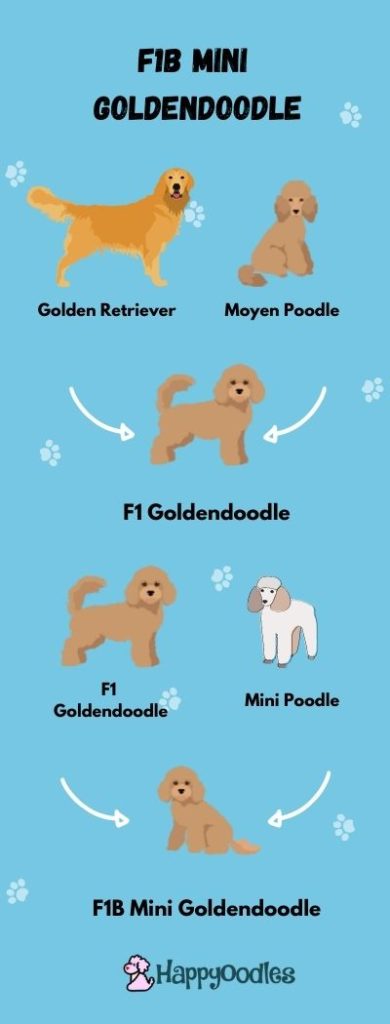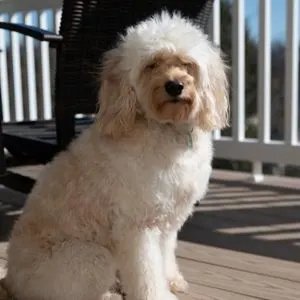Updated: 03/26/2024 – Are you on the hunt for a furry friend and find yourself drawn to the Mini Goldendoodle? You’re not alone! These miniature bundles of joy are rather popular, and for good reason.
First off, their size is just perfect for most homes. Weighing between 15 to 35 pounds, Mini Goldendoodles are compact enough for apartment living but still hearty enough for plenty of playtime.
This breed is the ideal middle ground for those who love the Goldendoodle’s charm but are looking for a smaller companion. They can also be the perfect size for someone looking for a dog they can take on pet friendly vacations.
But what truly sets them apart is their coat. Mini Goldendoodles (aka a designer dog) inherit a low-shedding coat from their Poodle lineage, making them a fantastic choice for families with pet allergy sufferers.
As a mini doodle owner myself, I know that these dogs are not just pretty faces with friendly dispositions. Mini Goldendoodles often serve as therapy dogs, thanks to their empathetic nature and gentle demeanor.
Eager to learn more about Mini Goldendoodles? Keep scrolling! We’ve got more insights on their traits, care, and health.

16 Need to Know Facts About The Mini Goldendoodle
1. Breeding
Similar to their standard-sized counterparts, a Mini Goldendoodle is a hybrid of a purebred Golden Retriever and a Poodle. However, the key difference lies in the size of the Poodle parent. For Mini Goldendoodles, a Golden Retriever is typically bred with either a Mini poodle or Toy Poodle.
Breed Standard
The Goldendoodle stands out among designer dogs for having an established breed standard, upheld by reputable breeders. However, it’s not recognized by the American Kennel Club as a purebred.
A little known fact about the Goldendoodle’s breed club is that they adopted an “Open Stud Book” policy. This allows any purebred Poodle, Golden Retriever, or Goldendoodle to be considered for breeding, aiming to diversify the Goldendoodle’s gene pool and mitigate health issues associated with limited genetic diversity.

Generation Classifications
Goldendoodle generations refer to the specific breeding combinations used to create these dogs. Understanding these generations is important because they can influence the dog’s appearance, size, coat type, and hypoallergenic qualities.
Here’s a breakdown of the most common Goldendoodle generations:
- F1 Mini Goldendoodle: This first-generation cross involves a purebred Miniature or Toy Poodle and a purebred Golden Retriever. The result is a Goldendoodle that’s typically 50% Poodle and 50% Golden Retriever.
- F1 B Mini Goldendoodle: An F1B is created by breeding an F1 Mini Goldendoodle back to a Miniature or Toy Poodle, making it 75% Poodle and 25% Golden Retriever. This generation often has a curlier coat and is more likely to be hypoallergenic, which is preferable for those with allergies.
- F3 or Multigenerational Mini Goldendoodles: These are Goldendoodles bred beyond the second generation. They can be a mix of various combinations like two F2 Mini Goldendoodles, or an F2B bred with an F1B.
For a more in-depth understanding of the Goldendoodle Generation visit our post on Goldendoodle Generations: F1, F1b, F1bb, F2, F2b, Etc

2. Is there more than one type of Goldendoodle?
Another little known fact about the Goldendoodle is that there are three types of Golden Retriever/Poodle Mix breeds; the English, the American and the Australian Goldendoodle. However, the three all trace back to the same Scottish lineage, with variations in appearance and size due to different breeding practices across the Atlantic.
English Goldendoodle
The English Goldendoodle is a cross between an English Golden Retriever, typically cream-colored, and a white or cream-colored Poodle, resulting in a predominantly cream or white Goldendoodle. English Golden Retrievers are known for being shorter and stockier compared to their American counterparts, with shorter, wavier fur.
American Goldendoodle
The American Goldendoodle is typically a mix of an American Golden Retriever, often red or apricot in color, with a Poodle of any color. This leads to a variety of shades in their offspring, ranging from cream and apricot to even black.
Australian Goldendoodle
The Australian Goldendoodle (aka mini Groodles) differs from its American and English counterparts. Rather than a direct Golden Retriever-Poodle mix, it’s a cross between an English Goldendoodle and an Australian Labradoodle.
The key distinction is that the Australian Goldendoodle can encompass up to seven different breeds in its lineage, as opposed to the two-breed mix of the American and English varieties.
Which is better? The mini Goldendoodle or the mini Labradoodle. We compare the two crossbreeds in our post Goldendoodle vs Labradoodle: Which is Better?

3. What is their temperament like?
The temperament of a Miniature Goldendoodle is generally friendly, affectionate, and outgoing. These dogs are known for their social and amiable nature, often showing a strong desire to bond with their human families.
Mini Goldendoodles are typically gentle and patient, making them great companions for families with children. They are also known for being adaptable, able to fit into various living situations, whether it’s a large house with a yard or a smaller apartment setting.
Being intelligent and eager to please, they are usually easy to train. This intelligence, combined with their social nature, often makes them excellent candidates for roles such as therapy or service dogs.
However, like any breed, individual temperaments can vary. Socialization and training from a young age are important to ensure that they grow up to be well-rounded and well-behaved dogs.
Also, due to their social nature, they may not do well with long periods of solitude and can be prone to separation anxiety if left alone for extended periods.
4. Are Mini Goldendoodle good apartment dogs?
Yes. Thanks to their size they can fit perfectly well into apartment life. If you train them early on to be comfortable when they are alone and if you provide them with enough exercise, mini Goldendoodles can live a very happy life in an apartment.

5. How big do they get?
The miniature Goldendoodle generally weighs between 15 to 35 pounds and can stand anywhere from 13 to 20 inches tall at the shoulder when fully grown. However, this range can differ based on the specific breeding.
If you are looking for a smaller doodle check out the Cockapoo and mini Cavapoo. Or maybe you want a bigger mini, then a Mini Bernedoodle may be a good choice
6. Is a Mini Goldendoodle good for travel?
The mini Goldendoodle makes a great travel companion. Their small size allows you to travel with ease. Plus, their friendly nature makes it easier to take them places.
If you plan to travel by air or train with them, make sure you get a mini Goldendoodle whose full-grown size is under 20 pounds. Most airlines and trains require dogs to be under 20 pounds. This includes the weight of the carrier.

7. Do they Shed?
Mini Goldendoodles are known for their low to moderate shedding. They inherit this trait from the Poodle side of their lineage, as Poodles are well-known for their hypoallergenic coats that shed very little. However, because Mini Goldendoodles are a crossbreed, the degree of shedding can vary.
An F1 Mini Goldendoodle (50% Golden Retriever and 50% Poodle) may shed more than an F1B Mini Goldendoodle (which is 75% Poodle). The more Poodle genetics a Mini Goldendoodle has, the less likely they are to shed significantly.
To learn more about shedding in Goldendoodles read our post on Do Goldendoodles Shed? The Truth about Shedding
8. Are they Hypoallergenic?
For allergy sufferers, the answer to whether Mini Goldendoodles are hypoallergenic is a bit of a mix – both yes and no. Here’s a closer look at why.
It is believed that dog allergies are commonly triggered by proteins found in a dog’s skin cells, saliva, or urine. When dogs shed their hair, they also release dander (tiny flakes of skin) into the air. This can be problematic for allergy sufferers, as inhaling dander can trigger allergic reactions.
However, Mini Goldendoodles often shed less. This reduced shedding means they’re less likely to release significant amounts of dander, potentially making them a more suitable option for those with allergies. To ensure minimal shedding, it’s crucial to find a breeder who conducts thorough genetic testing.
But shedding isn’t the only way allergy sufferers can be exposed to allergens. Contact with a dog through licking, petting, brushing, or cleaning up can also introduce these proteins to allergy sufferers.
For those concerned about allergies, the most effective strategy is to spend time with the Mini Goldendoodle you are looking to get. This experience can help gauge how your allergies might respond to their presence. But even this is not a guarantee that you won’t be allergic once you are living with them full-time.

9. Will my Mini Goldendoodle have long wavy hair?
Both the Golden Retriever and the Poodle typically have long hair on their bodies, and this trait is often passed on to Goldendoodles. However, the distinct long facial hair, prominent eyebrows, and wavy coat associated with the classic ‘doodle’ look depend on the inheritance of the furnishing gene. This gene, dominant and carried by the Poodle, only needs to be inherited once for the traits to be expressed.
Thus, an F1 Goldendoodle usually inherits this gene, resulting in the characteristic teddy bear appearance. However, in later multi-generational Goldendoodles, there’s a chance of not inheriting this gene if they receive two non-furnishing genes from the Golden Retriever lineage.
10. What colors do they come in?
The mini can come in a variety of colors. Goldendoodles can inherit any of the colors from either the Golden Retriever or Poodle.
Golden Retrievers carry genes for shades of cream, apricot and red, while Poodles can carry genes that include shades of cream, apricot, red, black, chocolate (dark brown), silver and gray coloring.
Another little known fact is that Poodles can carry fading gene that lighten their coat as they mature.

11. Are they easy to groom?
Mini Goldendoodles are relatively easy to groom, but they do require regular grooming to keep their coats healthy and to prevent matting, especially if they have a wavy or curly coat. Their grooming needs will depend on the type of coat they inherit – straighter coats like the Golden Retriever’s are generally easier to maintain, while curlier Poodle-like coats require more frequent and thorough grooming.
Key grooming tasks include regular brushing, at least a few times a week, to remove tangles and prevent mats from forming. Depending on the coat, some Mini Goldendoodles may need daily brushing. They also need baths, but not too frequently, as over-bathing can strip their coat of natural oils.
In addition to coat care, their grooming routine should include regular nail trims, ear cleaning to prevent infections (especially in dogs with floppy ears), and dental care.
Professional grooming every 6 to 8 weeks is required to keep the Mini Goldendoodle looking neat and to prevent skin and coat problems.
12. How much exercise do Mini Goldendoodles need?
Miniature Goldendoodles are high energy dogs, therefore they are happiest when they are moving. They need at least 60 minutes of exercise a day, ideally split into multiple sessions.
A mix of physical activities and mental stimulation, like walks, playtime, and interactive games, is beneficial. They adapt well to the owner’s lifestyle, so exercise can vary from longer hikes to shorter, more frequent walks.
Of course, all dogs are different and have different exercise needs. If your dog starts to get into trouble they probably need more exercise.

13. What are the health issues with a Mini Goldendoodle?
Miniature Goldendoodles are an overall healthy breed but they can develop health conditions that are common to both the Golden Retriever and miniature Poodle.
Your best chance of having a healthy dog is by getting them from a reputable breeder that does complete genetic health testing on their breeding dogs. Breeders that leave things up for chance may not know that they are breeding diseases into the dogs.
Goldendoodle health concerns include:
- Ear Infections – Due to their long hairy ears that can reduce air flow and increase moisture.
- Sebaceous adenitis – Skin disease
- Hip dysplasia – Condition in which the thigh bone becomes displaced from the hip joint. There is a strong genetic component with this condition, which can be avoided through genetic testing
- Subvalvular Aortic Stenosis – Disease which causes a narrowing at the aortic valve of the heart
- Addison’s disease – Also known as hypoadrenocorticism, this disease decreases hormone production from the outer part or cortex of the adrenal gland
- Various eye diseases – Common eye diseases include progressive retinal atrophy, cataracts and glaucoma
- Von Willebrand’s disease – a blood condition that affects clotting
For more information, see the Ribbon Requirements set by the Goldendoodle Association of North America

14. How long do they live?
Mini Goldendoodles typically have a lifespan of around 12 to 15 years. This range can vary depending on various factors including genetics, overall health, diet, and the level of care they receive.
Being a crossbreed, Mini Goldendoodles benefit from the phenomenon of “hybrid vigor,” where mixed-breed dogs often have fewer health problems and longer lifespans than their purebred counterparts. However, they can still inherit health issues common to their parent breeds.
15. Where can I find a Miniature Goldendoodle?
There are a few options when it comes to finding a Miniature Goldendoodle:

Reputable Breeders: Start by researching reputable breeders who specialize in Miniature Goldendoodles. Look for breeders who prioritize the health, temperament, and well-being of their dogs. They should be transparent about their breeding practices, health screenings for genetic conditions, and offer support for new owners.
Rescue Organizations and Shelters: Consider adopting from rescue organizations or shelters. While specific Miniature Goldendoodle rescues are rare, many general and breed-specific rescues occasionally have Goldendoodles. Adoption is a great option to provide a loving home to a dog in need.

16. How much does a Mini Goldendoodle Puppy Cost?
The cost of an 8-week-old Mini Golden doodle ranges from $500 all the way up to $12,000. How much you pay for a mini will depend on where you get them. On the lower end of the cost spectrum your puppy will most likely come from a puppy mill.
To learn more on the cost of a Goldendoodle mini and what you get for the price, check out our post on What does a Goldendoodle Cost?

Trying to decide between a mini Goldendoodle and a standard Goldendoodle. Check out our post in the subject to see which one might be a better fit.
So, is the Mini Goldendoodle the perfect dog?
While they have many great traits, they are not a low maintenance dog if you factor in their grooming, exercise and social needs. But if you are looking for a friendly, active dog that you can go places with, the mini might be perfect for you.
Is the Goldendoodle the right dog for you? Join us to find out why the Goldendoodle is not for everyone.
Bringing Home a Mini Goldendoodle
Once you decide you want a Mini Goldendoodle, you should start thinking about what you need for when you bring your puppy home. Puppies require many things, like a leash and collar, food bowls and toys.
One of the things you might not think about is where your puppy will go to the bathroom. Having an established place to train your puppy to go outside will make potty training easier. To learn more, check out our posts on Potty Training a Puppy: Made Easy and Outdoor Dog Potty Area Guide.
Miniature Goldendoodle Resources
